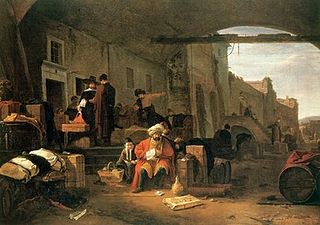
A merchant is a person who trades in commodities produced by other people, especially one who trades with foreign countries. Historically, a merchant is anyone who is involved in business or trade. Merchants have operated for as long as industry, commerce, and trade have existed. In 16th-century Europe, two different terms for merchants emerged: meerseniers referred to local traders and koopman referred to merchants who operated on a global stage, importing and exporting goods over vast distances and offering added-value services such as credit and finance.
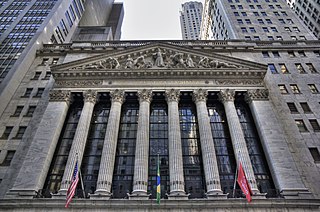
A stock exchange, securities exchange, or bourse is an exchange where stockbrokers and traders can buy and sell securities, such as shares of stock, bonds and other financial instruments. Stock exchanges may also provide facilities for the issue and redemption of such securities and instruments and capital events including the payment of income and dividends. Securities traded on a stock exchange include stock issued by listed companies, unit trusts, derivatives, pooled investment products and bonds. Stock exchanges often function as "continuous auction" markets with buyers and sellers consummating transactions via open outcry at a central location such as the floor of the exchange or by using an electronic trading platform.

A stock market, equity market, or share market is the aggregation of buyers and sellers of stocks, which represent ownership claims on businesses; these may include securities listed on a public stock exchange, as well as stock that is only traded privately, such as shares of private companies which are sold to investors through equity crowdfunding platforms. Investment is usually made with an investment strategy in mind.
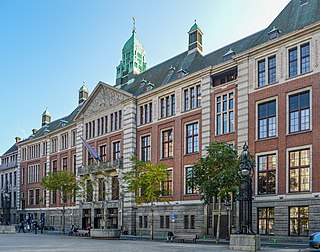
Euronext N.V. is a pan-European bourse that provides trading and post-trade services for a range of financial instruments.

Euronext Amsterdam is a stock exchange based in Amsterdam, the Netherlands. Formerly known as the Amsterdam Stock Exchange, it merged on 22 September 2000 with the Brussels Stock Exchange and the Paris Stock Exchange to form Euronext. The registered office of Euronext, itself incorporated in the Netherlands a public limited company, is also located in the exchange.

Louis Delacenserie (1838–1909) was a Belgian architect from Bruges. The spelling of his name differs greatly; De la Censerie, Delasencerie, Dela Censerie or Dela Sencerie are the most common alternative forms. His father was a merchant and building contractor from Tournai.
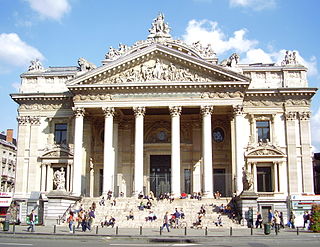
The Brussels Stock Exchange, abbreviated to BSE, was founded in Brussels, Belgium, by decree of Napoleon in 1801. In 2002, the BSE merged with the Amsterdam, Lisbon and Paris stock exchanges into Euronext, renaming the BSE Euronext Brussels. The most well known stock market index on the BSE is the BEL20.

A trader is a person, firm, or entity in finance who buys and sells financial instruments, such as forex, cryptocurrencies, stocks, bonds, commodities, derivatives, and mutual funds in the capacity of agent, hedger, arbitrageur, or speculator.
The Company of Merchants of the Staple of England, the Merchants of the Staple, also known as the Merchant Staplers, is an English company incorporated by Royal Charter in 1319 dealing in wool, skins, lead and tin which controlled the export of wool to the continent during the late medieval period. The company of the staple may perhaps trace its ancestry back as far as 1282 or even further.

The financial history of the Dutch Republic involves the interrelated development of financial institutions in the Dutch Republic. The rapid economic development of the country after the Dutch Revolt in the years 1585–1620 accompanied by an equally rapid accumulation of a large fund of savings, created the need to invest those savings profitably. The Dutch financial sector, both in its public and private components, came to provide a wide range of modern investment products beside the possibility of (re-)investment in trade and industry, and in infrastructure projects. Such products were the public bonds, floated by the Dutch governments on a national, provincial, and municipal level; acceptance credit and commission trade; marine and other insurance products; and shares of publicly traded companies like the Dutch East India Company (VOC), and their derivatives. Institutions like the Amsterdam stock exchange, the Bank of Amsterdam, and the merchant bankers helped to mediate this investment. In the course of time the invested capital stock generated its own income stream that caused the capital stock to assume enormous proportions. As by the end of the 17th century structural problems in the Dutch economy precluded profitable investment of this capital in domestic Dutch sectors, the stream of investments was redirected more and more to investment abroad, both in sovereign debt and foreign stocks, bonds and infrastructure. The Netherlands came to dominate the international capital market up to the crises of the end of the 18th century that caused the demise of the Dutch Republic.

An exchange, bourse, trading exchange or trading venue is an organized market where (especially) tradable securities, commodities, foreign exchange, futures, and options contracts are bought and sold.
A cloth hall or linen hall is a historic building located in the centre of the main marketplace of a European town. Cloth halls were built from medieval times into the 18th century.

Antwerp is the largest city in Belgium by area at 204.51 km2 (78.96 sq mi) and the capital of Antwerp Province in the Flemish Region. With a population of 536,079, it is the most populous municipality in Belgium, and with a metropolitan population of around 1,200,000 people, it is the second-largest metropolitan region in Belgium, second only to Brussels.

The Korenbeurs was a 17th-century commodity market in Amsterdam where grain was traded. The building stood on the banks of the Amstel, on the western side (Nieuwezijde) of the Damrak. It was directly south of the Oude Brug bridge, on a spot now occupied by the former stock and commodity exchange Beurs van Berlage.

Bruges is the capital and largest city of the province of West Flanders in the Flemish Region of Belgium, in the northwest of the country. It is the sixth most populous city in the country.
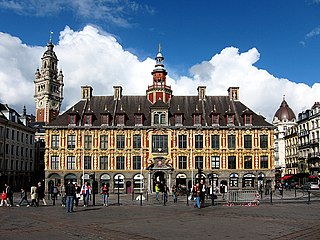
The Vieille Bourse in Lille is the former building of the Lille Chamber of Commerce and Industry. It is located between the Place du Général-de-Gaulle and the Place du Théâtre and is considered to be one of the landmarks of the city centre. The building is in the form of a quadrangle, made up of 24 identical houses enclosing an inner courtyard, which serves as a meeting place for booksellers, florists, chess players and tourists. This site is served by the Rihour metro station.
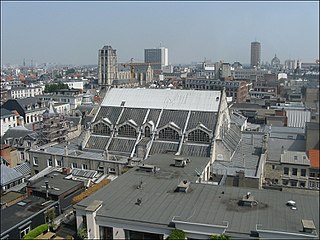
The bourse at Antwerp is a building in Antwerp, Belgium, which was first opened in 1531 as the world's first purpose-built commodity exchange. The Royal Exchange in London was modelled on the Antwerp bourse. The bourse has been described as "the mother of all stock exchanges".

Bartholomeus de Momper (I) or Bartholomeus de Momper the Elder (Antwerp, 1535 – Antwerp, between 1595-1597) was a Flemish publisher, printer, draughtsman and art dealer. He was a member of de Momper family, a prominent family of landscape painters and printmakers, originally from Bruges, which had settled in Antwerp in the 16th century.
















